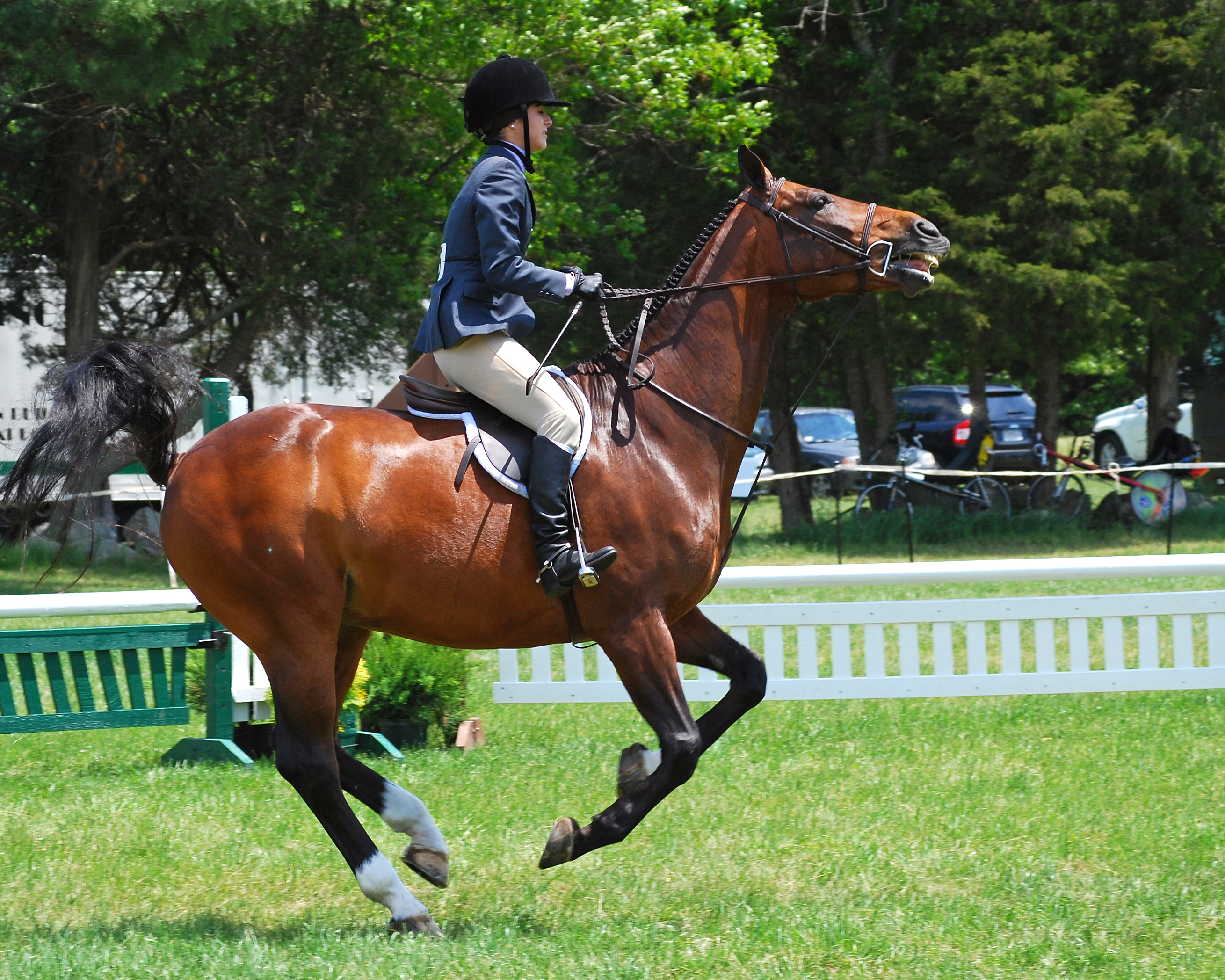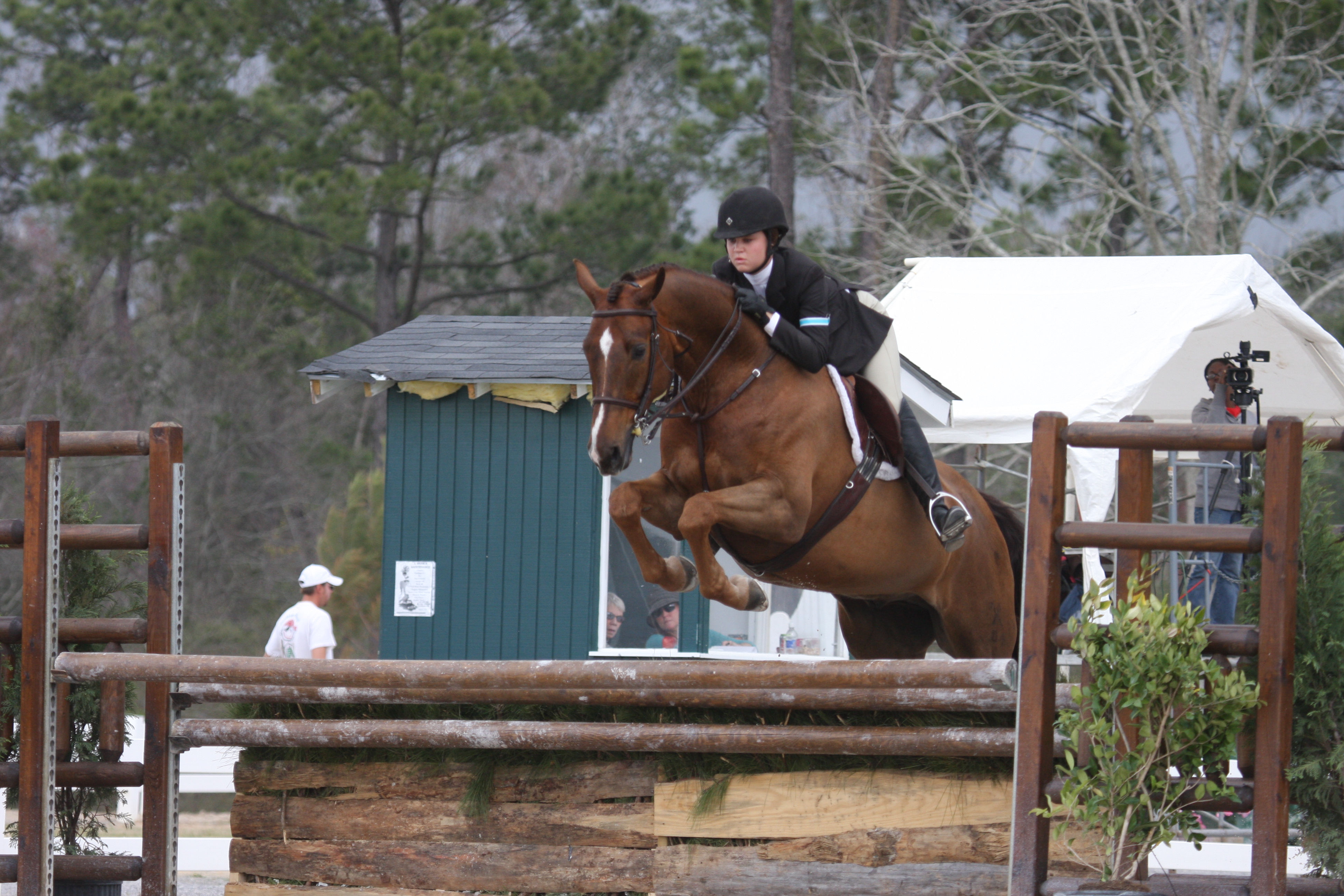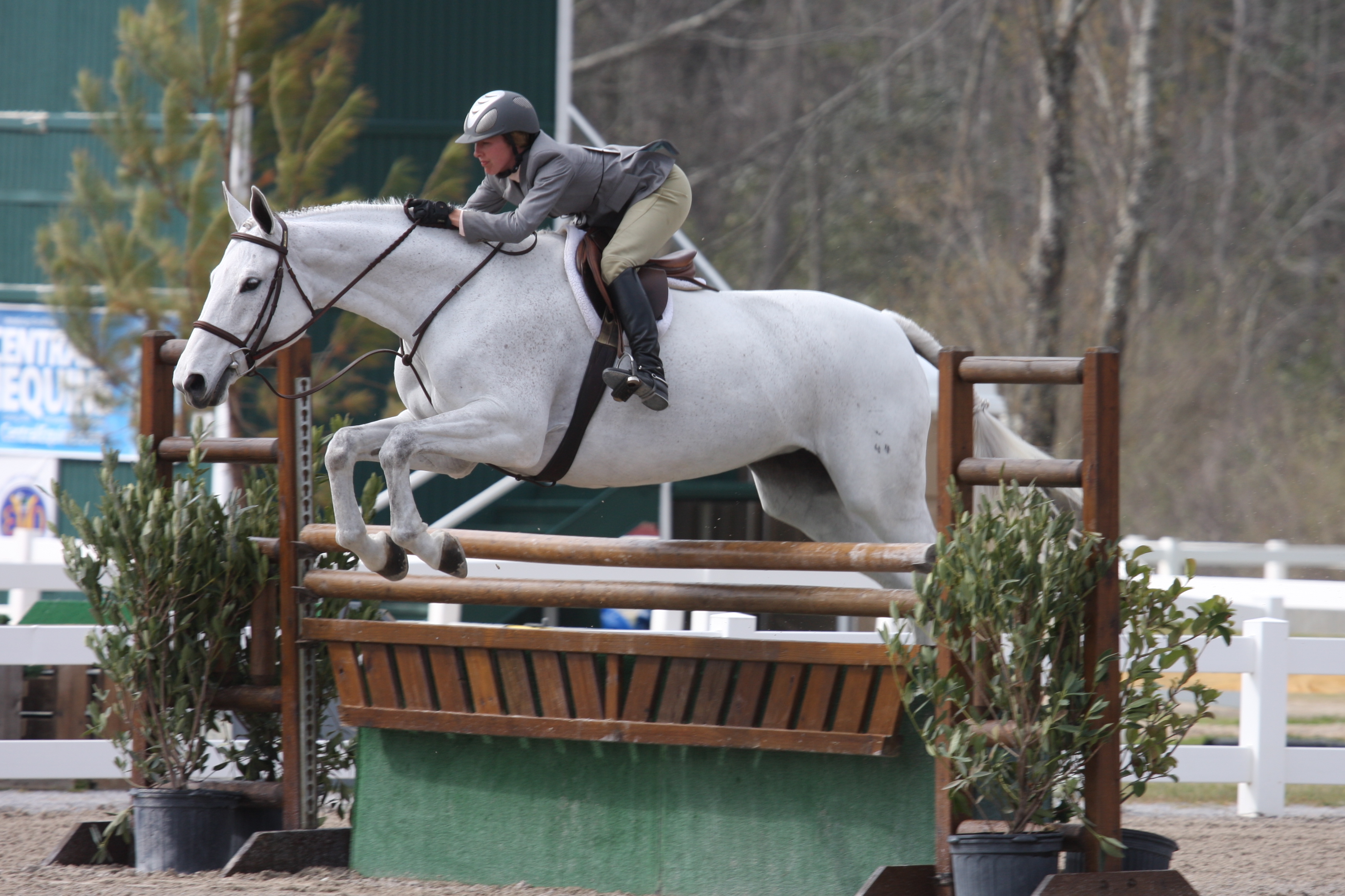|
Noseband
A noseband is the part of a horse's bridle that encircles the nose and jaw of the horse. In English riding, where the noseband is separately attached to its own headstall or crownpiece, held independently of the bit, it is often called a cavesson or caveson noseband. In other styles of riding, a simple noseband is sometimes attached directly to the same headstall as the bit. Development A noseband may have been one of the first tools used by humans to domesticate and ride horses. The bit developed later. The noseband was originally made of leather or rope. After the invention of the bit, the noseband was, in some cultures, demoted to a halter worn beneath the bridle that allowed the rider to remove the bit from the horse's mouth after work and leave a restraining halter on underneath, or to tie the horse by this halter, instead of by the bit, which could result in damage to the horse's mouth if it panicked. However, its ability to hold a horse's mouth shut over the bit was ... [...More Info...] [...Related Items...] OR: [Wikipedia] [Google] [Baidu] |
Bridle
A bridle is a piece of equipment used to direct a horse. As defined in the ''Oxford English Dictionary'', the "bridle" includes both the that holds a bit that goes in the mouth of a horse, and the reins that are attached to the bit. It provides additional control and communication through rein pressure (Oxford English Dictionary, n.d., para. 1). Headgear without a bit that uses a noseband to control a horse is called a hackamore, or, in some areas, a bitless bridle. There are many different designs with many different name variations, but all use a noseband that is designed to exert pressure on sensitive areas of the animal's face to provide direction and control. The bridle was devised by Indo-European herders of the Pontic-Caspian steppes to control horses between 3000 BC and 2000 BC. Parts The bridle consists of the following elements: * Crownpiece: The crownpiece, headstall (US) or headpiece (UK) goes over the horse's head just behind the animal's ears, at the pol ... [...More Info...] [...Related Items...] OR: [Wikipedia] [Google] [Baidu] |
Hackamore
A hackamore (or ) is a type of animal headgear which does not have a bit. Instead, it has a special type of noseband that works on pressure points on the face, nose, and chin. Hackamores are most often seen in western riding and other styles of riding derived from Spanish traditions, and are occasionally seen in some English riding disciplines such as show jumping and the stadium phase of eventing. Various hackamore designs are also popular for endurance riding. While usually used to start young horses, they are often seen on mature horses with dental issues that make bit use painful, and on horses with mouth or tongue injuries that would be aggravated by a bit. Some riders also like to use them in the winter to avoid putting a frozen metal bit into a horse's mouth. There are many styles, but the classic hackamore design features a ''bosal'' () noseband, and sometimes itself called a "bosal" or a "bosal hackamore". It has a long rope rein called a mecate and may al ... [...More Info...] [...Related Items...] OR: [Wikipedia] [Google] [Baidu] |
Double Bridle
A double bridle, also called a full bridle or Weymouth bridle,Gurney, Hilda. "Double Bridle Pros and Cons." ''Practical Horseman'' Sept. 2007. is a bridle that has two bits and four reins (sometimes called "double reins"). One bit is the '' bradoon'' (or ''bridoon''), is a modified snaffle bit that is smaller in diameter and has smaller bit rings than a traditional snaffle, and it is adjusted so that it sits above and in front of the other bit, a curb bit. Another term for this combination of curb and snaffle bit is a "bit and bradoon", where the word "bit" in this particular context refers to the curb. Uses Double bridles are most commonly associated with dressage and certain horse show classes where formal tack, attire and turnout are standard. They are required for upper level FEI dressage tests (Prix St. Georges (PSG), Intermediaries, and Grand Prix), and are optional at the USDF third and fourth levels. They are also permitted in the dressage phase of eventing at the Int ... [...More Info...] [...Related Items...] OR: [Wikipedia] [Google] [Baidu] |
King George III
George III (George William Frederick; 4 June 173829 January 1820) was King of Great Britain and King of Ireland, Ireland from 25 October 1760 until his death in 1820. The Acts of Union 1800 unified Kingdom of Great Britain, Great Britain and Kingdom of Ireland, Ireland into the United Kingdom of Great Britain and Ireland, with George as its king. He was concurrently Duke and Prince-elector of Electorate of Hanover, Hanover in the Holy Roman Empire before becoming King of Hanover on 12 October 1814. He was the first monarch of the House of Hanover who was born in Great Britain, spoke English as his first language, and never visited Hanover. George was born during the reign of his paternal grandfather, George II of Great Britain, King George II, as the first son of Frederick, Prince of Wales, and Princess Augusta of Saxe-Gotha. Following his father's death in 1751, Prince George became heir apparent and Prince of Wales. He succeeded to the throne on George II's death in 1760. Th ... [...More Info...] [...Related Items...] OR: [Wikipedia] [Google] [Baidu] |
Eventing
Eventing (also known as three-day eventing or horse trials) is an equestrian event where the same horse and rider combination compete against other competitors across the three disciplines of dressage, cross-country, and show jumping. This event has its roots in a comprehensive cavalry test that required mastery of several types of riding. The competition may be run as a one-day event (ODE), where all three events are completed in one day (dressage, followed by show jumping and then the cross-country phase) or a three-day event (3DE), which is more commonly now run over four days, with dressage on the first two days, followed by cross-country the next day and then show jumping in reverse order on the final day. Eventing was previously known as Combined Training, and the name persists in many smaller organizations. The term "Combined Training" is sometimes confused with the term "Combined Test", which refers to a combination of just two of the phases, most commonly dressage a ... [...More Info...] [...Related Items...] OR: [Wikipedia] [Google] [Baidu] |
Standing Martingale
A martingale is any of several designs of tack that are used on horses to control head carriage. Martingales may be seen in a wide variety of equestrian disciplines, both riding and driving. Rules for their use vary widely; in some disciplines they are never used, others allow them for schooling but not in judged performance, and some organizations allow certain designs in competition. The two most common types of martingale, the standing and the running, are used to control the horse's head height, and to prevent the horse from throwing its head so high that the rider loses control over the horse's speed, direction and shape of body. When a horse's head gets above a desired height, the martingale places pressure on the head so that it becomes more difficult or impossible to raise it higher. The standing martingale The standing martingale, also known as a "tiedown" or a "head check",The Pony Club Association of NSW, "Handbook", Simpson & Sons, 1982 has a single strap which i ... [...More Info...] [...Related Items...] OR: [Wikipedia] [Google] [Baidu] |
Show Jumping
Show jumping is a part of a group of English riding equestrian events that also includes eventing, hunters, and equitation. Jumping classes are commonly seen at horse shows throughout the world, including the Olympics. Sometimes shows are limited exclusively to jumpers. Sometimes jumper classes are offered in conjunction with other English-style events. Sometimes, show jumping is but one division of a very large, all-breed competition that includes a very wide variety of disciplines. Jumping classes may be governed by various national horse show sanctioning organizations, such as the United States Equestrian Federation or the British Showjumping Association. International competitions are governed by the rules of the International Federation for Equestrian Sports. Hunters or jumpers Show jumping events have hunter classes, jumper classes and hunt seat equitation classes. Hunters are judged subjectively on the degree to which they meet an ideal standard of manners, s ... [...More Info...] [...Related Items...] OR: [Wikipedia] [Google] [Baidu] |
Field Hunter
A field hunter, or a fox hunter, is a type of horse used in the hunt field for fox hunting and stag hunting. Characteristics The field hunter may be of any breed, but should possess stamina, a level head, and bravery. The horse should have a safe jump, so as not to get caught on any of the solid obstacles found in the hunt field. The type of terrain is also an important factor: wide open, flat land is generally best for horses of a Thoroughbred type, while rockier, more unforgiving land may be best suited by a draft-cross or tougher breed. Field hunter trials Field hunter trials are regularly held to test these horses, and have become a popular form of equestrian competition. Often the horses are judged over several days of fox hunting, with the best of the group performing in the "handy hunter" class. The handy hunter class may ask for the horse and rider pair to trot a log, open and close a gate while mounted, jump several fences, and for the rider to dismount and remount. ... [...More Info...] [...Related Items...] OR: [Wikipedia] [Google] [Baidu] |
Equitation
Equitation is the art or practice of horse riding or horsemanship. More specifically, equitation may refer to a rider's position while mounted, and encompasses a rider's ability to ride correctly and with effective aids. In horse show competition, the rider, rather than the horse is evaluated. Such classes go by different names, depending on region, including ''equitation classes'', ''rider classes'', or ''horsemanship classes.'' Judging criteria covers the rider's performance and control of the horse, use of riding aids, proper attire, correct form, and usually factor in rider poise and the cleanliness and polish of horse, rider and equipment. The performance of the horse is not judged ''per se'', but a poorly performing horse is considered to reflect the ability of the rider. Equitation classes occur in the Hunt seat, Saddle seat, Dressage, and Western disciplines. A good equitation rider is always in balance with the horse, maintains a correct position in every gait, moveme ... [...More Info...] [...Related Items...] OR: [Wikipedia] [Google] [Baidu] |
Saddle Seat
Saddle seat is a style of equestrianism, horse riding within the category of English riding that is designed to show off the high action of certain list of horse breeds, horse breeds. The style developed into its modern form in the United States, and is also seen in Canada and South Africa. To a much lesser extent, it is ridden with American horse breeds in Europe and Australia. The goal of the saddle seat riding style is to show off the horse's extravagant gaits, particularly the trot. It is not to be confused with the various hunt seat disciplines. History Saddle seat riding began as a distinct style within the broader group of English riding disciplines developed in the United States. The first source was the Plantation tradition of the Southern United States, American South, where smooth-moving, high-stepping horses were used by plantation owners and overseers to travel across the fields. The horses had to be smooth riding and comfortable enough for hours of riding while over ... [...More Info...] [...Related Items...] OR: [Wikipedia] [Google] [Baidu] |
Show Hunter
The Hunter division is a branch of horse show competition that is judged on the horse's performance, soundness and when indicated, conformation, suitability or manners. A "show hunter" is a horse that competes in this division. Show hunters, ideally, show many qualities that were rewarded in the fox hunting field such as manners, fluid movement, and correct jumping style. They are shown in hunt seat style tack. Any breed can be exhibited, but at the highest levels they are usually of Warmblood or Thoroughbred type, though a hunter-style pony is also seen in youth classes. Some classes are restricted to horses of certain breeds or height. In the United States, show hunters are primarily exhibited over fences in various divisions, including Green Hunter, Working Hunter, Conformation Hunter and so on, with a few additional classes offered for horses shown in-hand or on the flat, known as "Hunter Under Saddle." In the United Kingdom, competition over fences is called "Working ... [...More Info...] [...Related Items...] OR: [Wikipedia] [Google] [Baidu] |






